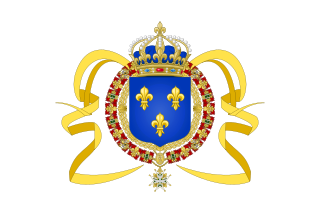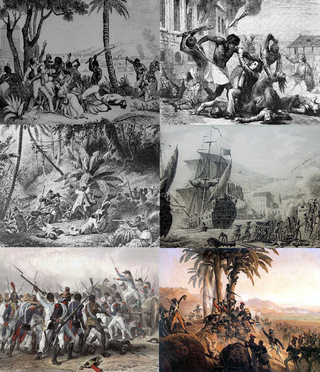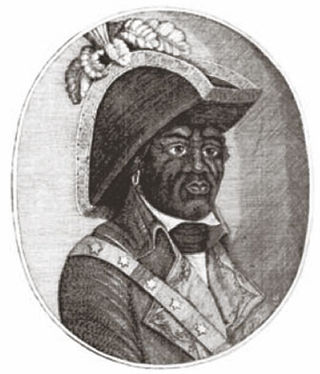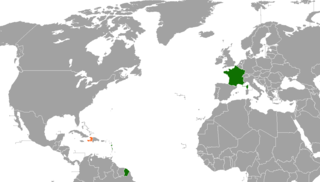Related Research Articles

François-Dominique Toussaint Louverture also known as Toussaint L'Ouverture or Toussaint Bréda, was a Haitian general and the most prominent leader of the Haitian Revolution. During his life, Louverture first fought and allied with Spanish forces against Saint-Domingue Royalists, then joined with Republican France, becoming Governor-General-for-life of Saint-Domingue, and lastly fought against Bonaparte's republican troops. As a revolutionary leader, Louverture displayed military and political acumen that helped transform the fledgling slave rebellion into a revolutionary movement. Along with Jean-Jacques Dessalines, Louverture is now known as one of the "Fathers of Haiti".

Jean-Jacques Dessalines was the first Haitian Emperor, and leader of the Haitian Revolution, and the first ruler of an independent Haiti under the 1805 constitution. Initially regarded as governor-general, Dessalines was later named Emperor of Haiti as Jacques I (1804–1806) by generals of the Haitian Revolutionary army and ruled in that capacity until being assassinated in 1806. He spearheaded the resistance against French massacres upon Haitians, and eventually became the architect of the 1804 Haitian Massacre against the remaining French residents of Haiti, including some supporters of the revolution. Alongside Toussaint Louverture, he has been referred to as one of the fathers of the nation of Haiti.

Saint-Domingue was a French colony in the western portion of the Caribbean island of Hispaniola, in the area of modern-day Haiti, from 1697 to 1804. The name derives from the Spanish main city on the island, Santo Domingo, which came to refer specifically to the Spanish-held Captaincy General of Santo Domingo, now the Dominican Republic. The borders between the two were fluid and changed over time until they were finally solidified in the Dominican War of Independence in 1844.

Alexandre Sabès Pétion was the first president of the Republic of Haiti from 1807 until his death in 1818. One of Haiti's founding fathers, Pétion belonged to the revolutionary quartet that also includes Toussaint Louverture, Jean-Jacques Dessalines, and his later rival Henri Christophe. Regarded as an excellent artilleryman in his early adulthood, Pétion would distinguish himself as an esteemed military commander with experience leading both French and Haitian troops. The 1802 coalition formed by him and Dessalines against French forces led by Charles Leclerc would prove to be a watershed moment in the decade-long conflict, eventually culminating in the decisive Haitian victory at the Battle of Vertières in 1803.

Artibonite (French) or Latibonit is one of the ten departments of Haiti located in central Haiti. With an area of 4,887 km2 it is Haiti's largest department. As of 2015, its estimated population was 1,727,524. The region is the country's main rice-growing area. The main cities are Gonaïves and Saint-Marc. In February 2004 an insurgency tried unsuccessfully to declare Artibonite's independence.

Nord (French) or Nò is one of the ten departments of Haiti and located in northern Haiti. It has an area of 2,114.91 km2 (816.57 sq mi) and a population of 1,067,177 (2015). Its capital is Cap-Haïtien.

The Haitian Revolution was a successful insurrection by self-liberated slaves against French colonial rule in Saint-Domingue, now the sovereign state of Haiti.
Jean-François Papillon was one of the principal leaders in the Haitian Revolution against slavery and French rule. He led the initial uprising of enslaved workers and later allied with Spain against the French.

George Biassou was an early leader of the 1791 slave rising in Saint-Domingue that began the Haitian Revolution. With Jean-François and Jeannot, he was prophesied by the vodou priest Dutty Boukman to lead the revolution.

The Battle of Vertières was the last major battle of the Haitian Revolution, and the final part of the Revolution under Jean Jacques Dessalines. It was fought on 18 November 1803 between the enslaved Haitian army and Napoleon's French expeditionary forces, who were committed to regaining control of the island.
The War of Knives, also known as the War of the South, was a civil war from June 1799 to July 1800 between the Haitian revolutionary Toussaint Louverture, a black ex-slave who controlled the north of Saint-Domingue, and his adversary André Rigaud, a mixed-race free person of color who controlled the south. Louverture and Rigaud fought over de facto control of the French colony of Saint-Domingue during the war. Their conflict followed the withdrawal of British forces from the colony earlier during the Haitian Revolution. The war resulted in Toussaint taking control of the entirety of Saint-Domingue, and Rigaud fleeing into exile.

Jean-Baptiste Belley was a Saint Dominican and French politician. A native of Senegal and formerly enslaved in the colony of Saint-Domingue, in the French West Indies, he was an elected member of the Estates General, the National Convention, and the Council of Five Hundred during the French First Republic. He was also known as Mars.

In the history of the Dominican Republic, the period of Era de Francia occurred in 1795 when France acquired the Captaincy General of Santo Domingo, annexed it into Saint-Domingue and briefly came to acquire the whole island of Hispaniola by the way of the Treaty of Basel, allowing Spain to cede the eastern province as a consequence of the French Revolutionary Wars.

The Saint-Domingue expedition was a large French military invasion sent by Napoleon Bonaparte, then First Consul, under his brother-in-law Charles Victor Emmanuel Leclerc in an attempt to regain French control of the Caribbean colony of Saint-Domingue on the island of Hispaniola, and curtail the measures of independence and abolition of slaves taken by the former slave Toussaint Louverture. It departed in December 1801 and, after initial success, ended in a French defeat at the Battle of Vertières and the departure of French troops in December 1803. The defeat forever ended Napoleon's dreams of a French empire in the West.

The Haitian Declaration of Independence was proclaimed on 1 January 1804 in the port city of Gonaïves by Jean-Jacques Dessalines, marking the end of 13-year long Haitian Revolution. The declaration marked Haiti becoming the first independent nation of Latin America and only the second in the Americas after the United States.

France–Haiti relations are foreign relations between France and Haiti. Both nations are members of the Organisation internationale de la Francophonie, United Nations, and the World Trade Organization.
Afro-Haitians or Black Haitians are Haitians who trace their full or partial ancestry to Sub-Saharan Africa. They form the largest racial group in Haiti and together with other Afro-Caribbean groups, the largest racial group in the region.

The Indigenous Army, also known as the Army of Saint-Domingue was the name bestowed to the coalition of anti-slavery men and women who fought in the Haitian Revolution in Saint-Domingue. Encompassing both black slaves, maroons, and affranchis, the rebels were not officially titled the Armée indigène until January 1803, under the leadership of then-general Jean-Jacques Dessalines. Predated by insurrectionists such as François Mackandal, Vincent Ogé and Dutty Boukman, Toussaint Louverture, succeeded by Dessalines, led, organized, and consolidated the rebellion. The now full-fledged fighting force utilized its manpower advantage and strategic capacity to overwhelm French troops, ensuring the Haitian Revolution was the most successful of its kind.
The French revolutionary government granted citizenship and freedom to free people of color in May 1791, but white planters in Saint-Domingue refused to comply with this decision. This was the catalyst for the 1791 slave rebellion, a key event for the Haitian Revolution with which the new citizens demanded their granted rights.
Independence Day in Haiti is celebrated annually as a public holiday on every 1st of January along with New Years Day, commemorating the nation's liberation from the French Empire. It also marks the birth of the world's first independent black republic, one achieved through an unprecedented successful slave revolt with the Haitian Revolution.
References
- ↑ Copied from the article Declaration of the Rights of Man and of the Citizen
- ↑ Copied from the article Jean-Baptiste Belley
- ↑ Edmond, Louisket (2010). The Tears of Haiti. Xlibris. p. 42. ISBN 978-1-4535-1770-3. LCCN 2010908468 . Retrieved 10 July 2015.
- ↑ Senauth, Frank (2011). The Making and Destruction of Haiti. Bloomington, Indiana, USA: AuthorHouse. p. 1. ISBN 978-1-4567-5384-9. LCCN 2011907203.
- ↑ Haydn, Joseph; Benjamin Vincent (1860). A Dictionary of Dates Relating to All Ages and Nations: For Universal Reference Comprehending Remarkable Occurrences, Ancient and Modern, The Foundation, Laws, and Governments of Countries-Their Progress In Civilization, Industry, Arts and Science-Their Achievements In Arms-And Their Civil, Military, And Religious Institutions, And Particularly of the British Empire. p. 321. Retrieved 12 September 2015.
- ↑ Copied from the article Haiti
- ↑ Copied from the article Saint-Domingue
- ↑ John K. Thornton. I Am the Subject of the King of Congo: African Political Ideology and the Haitian Revolution Archived 23 July 2008 at the Wayback Machine . Millersville University of Pennsylvania
- ↑ Copied from the article 1791 slave rebellion
- ↑ J. M. Thompson, The French Revolution (1943) identifies a series of major and minor mistakes and mishaps, pp. 224–227
- ↑ Copied from the article Georges Biassou
- ↑ Geggus, David (2011). Canny, Nicholas; Morgan, Philip (eds.). "The Haitian Revolution in Atlantic Perspective". The Oxford Handbook of the Atlantic World. 1. doi:10.1093/oxfordhb/9780199210879.013.0031.
- ↑ Copied from the article Haitian Declaration of Independence